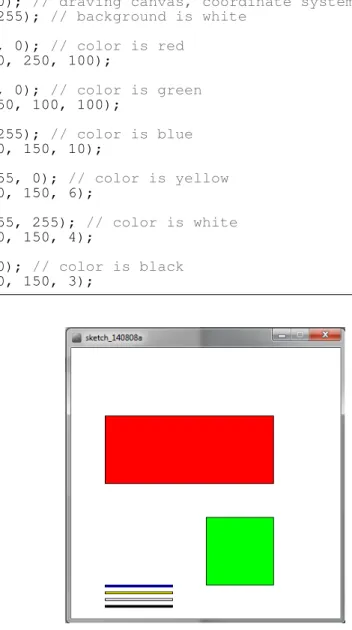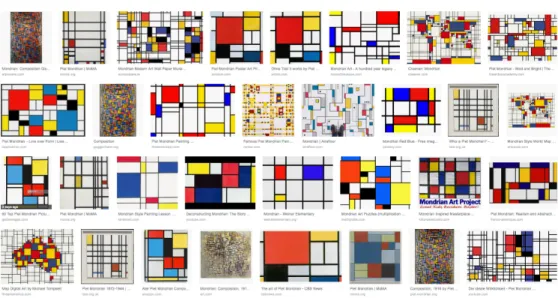Creative Coding
Beat Rossmy and Albrecht Schmidt Edition 2020,
Class at LMU Munich
Creative Coding
Implementing an •-Exhibition
B EAT R OSSMY AND A LBRECHT S CHMIDT
EDITION2020
THIS BOOK IS WORK IN PROGRESS AND BASED ON A CLASS ATLMU MUNICH
Cover Design by Maya Czupor Copyright c 2019 Copyright c 2020 what license? should discuss thi...
Table of Contents
1
Programming and Creative Coding. . . 71.1 Concept of this Book 7
1.2 The Goal: an •-Exhibition 7
1.3 Target Group and Expected Skills 8
2
Aesthetics and Information . . . 92.1 Programming a Random Mondrian 9
2.2 Random Creation and Aesthetics 11
2.3 Encoding Information in Art 11
2.4 Tasks - 1st lecture 12
3
Pixel based Art . . . 143.1 Programming a "Pixel Converter" 14
3.2 Convert to: Pointillism 16
3.3 Convert to other styles 16
3.4 Tasks - 2nd lecture 16
4
Virtual Brushes . . . 184.1 Programming a "virtual brush" 18
4.2 Implement: Finite Color 20
6
4.3 Image Brushes 20
4.4 Tasks - 3rd lecture 20
5
Lines . . . 215.1 Frieder Nake 21
5.2 Implement: Specify Angles 23
5.3 What else to implement? 23
5.4 Tasks - 3rd lecture 23
6
Fractals and Recursive Structures . . . 246.1 Nature 24
6.2 How can we change the code? 26
6.3 Tasks - 5rd lecture 26
7
Input and Output . . . 277.1 Intro 27
7.2 Video 28
7.3 Audio 28
7.4 Tasks - 7th lecture 29
Concept of this Book The Goal: an•-Exhibition Target Group and Expected Skills
1. Programming and Creative Coding
1.1 Concept of this Book
The concept of the book is to get people excited for programming artistic pieces. In this book we teach basic concepts that make up building blocks for interactive and potentially artistic programs.
The focus is to help the reader to create creative software and to learn how to program such software.
The artistic part is up to the reader, but we hope to give good starting points, where readers can bring in their creativity.
In parts we suggest critical reflection on creative coding and programming art pieces. In the lecture at LMU this is done as discussions, that are not captured in the book. We recommend readers to show their ideas and programs to other and discuss and defend it. This aids reflection and learning, similar to what we do in the course.
Besides the programming concepts and the implementation techniques, we discuss different topics, including:
• How aesthetics can be programmed?
• Creativity vs. determined by algorithms?
• Creative information visualization vs. art?
• Evolutionary systems and creativity?
• ...
1.2 The Goal: an •-Exhibition
In the course we create different interactive software programs. With the selection of the topics we try to cover many different programming concepts and implementation techniques.
All the programs are designed to create changing new outputs, either after some time or based on user interaction. All programs together can then be set-up as an exhibition that is ever changing, which we call an•-Exhibition. If the screens with the software are set-up in a circle, where screens face outwards, a visitor of the exhibition can walk around an will always see new exhibits.
8 Chapter 1. Programming and Creative Coding 1.3 Target Group and Expected Skills
The course and book is designed for readers studying at the intersection of art, media, and technology.
We expect that readers have an interest in interactive art and that they want to improve their abilities to create interactive installations.
We expect that readers have basic programming skills in processing. If readers have no program- ming skills at all, we suggest to do an introductory tutorial (e.g.https://processing.org/
tutorials/). For readers with programming experience in another languages, we expect that they can follow the course and read up on processing details as they go along.
Programming a Random Mondrian Random Creation and Aesthetics Encoding Information in Art Tasks - 1st lecture
2. Aesthetics and Information
The oeuvre of many famous modern painters includes very abstract paintings reduced to simple geometric forms, primary colours and clear pictorial structures. When you look at such paintings, many of you will think that they are easy to copy. At first sight you can grasp the colour palette, the organisation of the forms or simply the whole picture pattern. This allows us to visually separate a Mondrian from a Malevich. But can our understanding of these images be easily formalized and captured as an algorithm?
2.1 Programming a Random Mondrian
Following this idea, the first task of the book is to use Processing to recreate a mondrianesque image.
Implement a program that creates a drawing that is inspired by Mondrian.
Figure 2.1: Example of a Mondrian Painting.
The program should create a new picture every 120 seconds or when the user presses a button on the keyboard.
10 Chapter 2. Aesthetics and Information
Useful Commands
1 void keyPressed();
2 random();
3 randomSeed();
4 second();
5 minute();
6 hour();
⌅
The following listing is a starting point for your project.
1 size(400,400); // draving canvas, coordinate systems
2 background(255); // background is white
3
4 fill(255, 0, 0); // color is red
5 rect(50, 100, 250, 100);
6
7 fill(0, 255, 0); // color is green
8 rect(250, 250, 100, 100);
9
10 fill(0, 0, 255); // color is blue
11 rect(50, 320, 150, 10);
12
13 fill(255, 255, 0); // color is yellow
14 rect(50, 340, 150, 6);
15
16 fill(255, 255, 255); // color is white
17 rect(50, 360, 150, 4);
18
19 fill(0, 0, 0); // color is black
20 rect(50, 380, 150, 3);
Figure 2.2: Resulting Image from the example code.
Seehttps://processing.org/reference/random_.htmlfor examples how to use the random function.
2.2 Random Creation and Aesthetics 11 2.2 Random Creation and Aesthetics
Experiment with the parameters in the random creation. Explore the impact of parameters such as the size, dimension, line width, colors, and number of element on the aesthetics of the resulting picture.
Why are some pictures are aesthetically more pleasing than others? How can you change your algorithm to always create aesthetic drawings, while still having a great variety?
2.3 Encoding Information in Art
People have discussed the idea of informative art, see [Fer07; HS03; RSH00]. Can this utilitarian approach to creating visual displays based on know artworks be considered art?
Create a display that shows the time. Take a well know artwork as inspiration and encode the time in your visualization (a 15 minutes resolution is sufficient). To a casual observer it should not be apparent that the visualization shows the time.
What are the difficulties in designing such a visual display?
The following listing shows a basic clock. You can use this as a starting point for your own project.
1 // Variabeln definieren - ausserhalb von setup() und draw()
2 // da sie in beiden Funktionen verwendet werden
3 int stunde, minute, sekunde;
4
5 void setup() {
6 // Fenstergroesse festlegen
7 size(260, 100);
8
9 // Variabeln mit 0 initialisieren
10 stunde = 0;
11 minute = 0;
12 sekunde = 0;
13
14 // die Funktion draw() wird 2x pro Sekunde ausgefuehrt
15 frameRate(2);
16 }
17
18 void draw() {
19 // loesche den Hintergrund: setze ihn schwarz20background(0);
20 // setze Zeichenfarbe fuer Text und Recheck: weiss
21 fill(255, 255, 255);
22
23 // speichere in den Variablen die aktuelle Zeit
24 stunde = hour();
25 minute = minute();
26 sekunde = second();
27
28 // Kontrollausgabe der Zeit in der Console - kann spaeter geloeschtwerden
29 // in processing kann man mit "+" einen String aus Buchstaben und Zahlenbauen
30 println(stunde + ":" + minute + ":" + sekunde);
31
32 // zeige die Zeit im Fenster an
33 textSize(32);
34 text(stunde + ":" + minute + ":" + sekunde, 10, 30);
35
36 // zeichne einen Sekundenbalken
12 Chapter 2. Aesthetics and Information
37 // Sekunde hat einen wert von 0 bis 59
38 // Sekunde multipliziert mit 4 hat einen Wert zwischen 0 und 236
39 rect(10, 40, sekunde*4, 20);
40 }
Ther is another example of a analog clock that may be helpful:https://processing.org/
examples/clock.html
2.4 Tasks - 1st lecture
In the 1st session we try to mimic paintings of the famous dutch painter Piet Mondrian. He is famous for his abstract paintings that are reduced to a minimal palette of colors and geometric structures.
His systematic approach invites to be recreated with algorithms.
Preparation
If Processing isn’t already installed on your computer, go to https://processing.org/
download/download the program and install it on your machine. Open some example sketches and familiarize yourself with the Processing IDE. If you feel comfortable, proceed with the following task.
Breakout Session
During the following task we try to approach the generation of random Mondrianesque images in a systematic way. Step by step we go from the analysis of real and fake Mondrians, over theoretical concepts for the description of Mondrianesque structures, to working implementations of the algorithm.
• Search on the internet for pictures of the painter Mondrian (see Figure 2.3). What are the connecting commonalities? Can you spot artworks not painted by Mondrian? Try to figure out the "recipe" that makes a distinguishable Mondrian.
• Let us discuss your approach to generate Mondrianesque images with the help of an algorithm.
Try to sketch such structures and formalize them first.
• Try to implement one of the approaches we discussed in the plenum. Does it lead to the expected result? Does it work as simply as expected or have there been unexpected complications?
• If your algorithm is working, try to extend it to add your own style to the generated "Mondrians".
Tweak parameters, change the color palette or even introduce more randomness.
Discussion
We just created algorithms that mimic the style of a famous artist. Let us discuss your impressions and thoughts along the way. As a starting point think about the following questions:
• Can you call the product of these algorithms "art"?
• Can art in general be scripted? (Pollock, Warhol, ...)
• Does the used technology influence such a differentiation? (Style transfer performed with neural networks vs classic "conditional" algorithms)
Homework
1. Reading:Read the following papers [Fer07; HS03; RSH00] and write a short (300-500 words) essay on Informative Art. Your essay should contain an explanation what it is, why people would want to do it, pros and cons.
2.4 Tasks - 1st lecture 13
Figure 2.3: Artworks painted by Mondrian and Mondrian-inspired artworks.
2. Implementation:Create a display that shows the time. Take Mondrian algorithm and encode the time in your visualization (a 15 minutes resolution is sufficient).
3. Collect feedback on your implementation. Record 3 videos from people seeing your implementation (15 seconds each).
Bibliographie
[Fer07] Alois Ferscha. “Informative art display metaphors”. In:
International Conference on Universal Access in Human-Computer Interaction. Springer.
2007, pages 82–92 (cited on pages 11, 12).
[HS03] Lars Erik Holmquist and Tobias Skog. “Informative art:
information visualization in everyday environments”. In:
Proceedings of the 1st international conference on Computer graphics and interactive techniques in Australasia and South East Asia.
ACM. 2003, pages 229–235 (cited on pages 11, 12).
[Nak05] Frieder Nake. “Computer art: a personal recollection”. In:
Proceedings of the 5th conference on Creativity & cognition. ACM. 2005, pages 54–62 (cited on pages 23, 26).
[RSH00] Johan Redström, Tobias Skog, and Lars Hallnäs. “Informative art: using amplified artworks as infor- mation displays”. In: Proceedings of DARE 2000 on Designing augmented reality environments.
ACM. 2000, pages 103–114 (cited on pages 11, 12).


